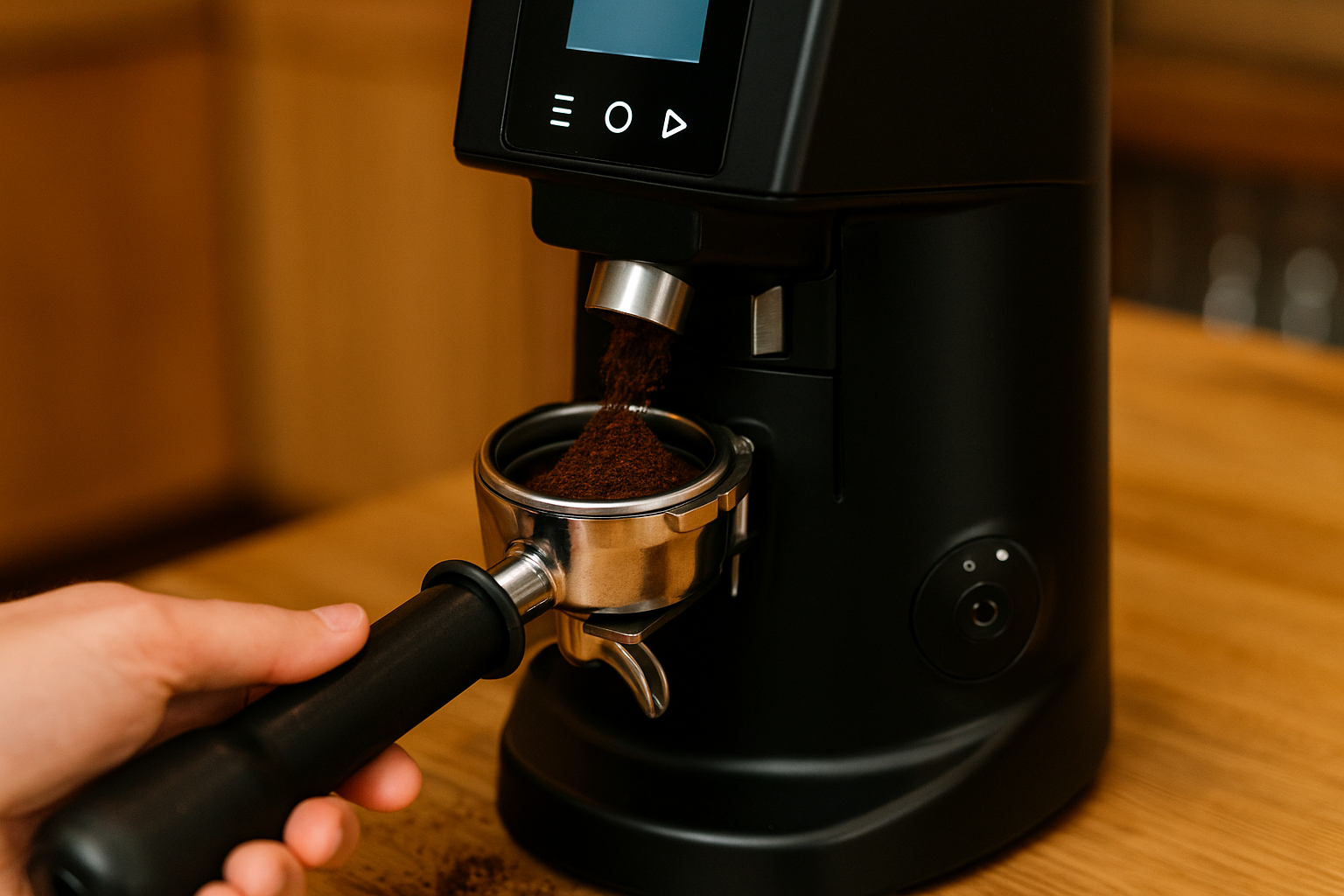Coffee grinding is undergoing a technological transformation. From manual burr grinders to fully automated smart systems, the way we prepare coffee beans is evolving fast.
Precision, consistency, and real-time control are becoming the new standard for professionals and home baristas alike.
In this post, we explore the rise of smart grinders, how they work, what makes them different, and how they can completely change your brewing routine.
Why Grinding Matters More Than You Think
Grinding is often underestimated. Many coffee drinkers focus on beans, machines, or water—but the grind itself is what controls extraction. A few seconds or microns off, and you can over-extract or under-extract your coffee.
Grind size determines:
- How fast water flows through coffee grounds
- How evenly flavors are extracted
- Whether your brew is balanced, bitter, or sour
A good grinder maintains consistency, and a smart grinder goes even further.
What Is a Smart Grinder?
A smart grinder uses technology to offer more precise control over grind settings, adjust automatically in real time, and often connect to apps or machines.
Key features include:
- Micrometric step-less grind adjustments
- Real-time grind correction
- Dose-by-weight functionality
- Environmental sensors (temperature, humidity)
- App connectivity and presets
These machines can remember your favorite grind settings for different brew methods and coffees, and they auto-calibrate to maintain consistency.
Traditional vs. Smart Grinders
A traditional grinder often uses mechanical dials or levers to change grind size. While accurate, they require manual calibration. Results can vary due to burr wear, humidity, or user error.
Smart grinders eliminate these inconsistencies. They:
- Auto-adjust grind size based on brewing conditions
- Use memory and sensors to adapt over time
- Improve workflow and reduce wasted beans
- Make fine-tuning accessible to beginners
How Real-Time Adjustments Work
Imagine grinding a shot of espresso and your machine notices the dose is 1g too light. Instead of just stopping, it adds more. Or it senses that the humidity in the room increased, which could slow your shot. It then adjusts the grind slightly finer.
This is the power of feedback systems.
Real-time adjustment is possible because smart grinders:
- Measure output during grinding
- Detect inconsistencies
- Adjust burr distance electronically
- Apply correction before the next grind
This maintains consistency even when using different coffees or brewing back-to-back.
Key Components of a Smart Grinder
Let’s break down what makes a smart grinder tick.
1. Digital Control Panel
These panels allow users to select grind size in microns or steps. Some feature touchscreens or even color coding. This improves clarity and makes switching between settings fast and easy.
2. Weight-Based Grinding
Instead of relying on timers, weight-based systems use built-in scales to grind exactly the grams needed. This ensures precise dosing every time.
3. Burr Distance Sensors
These sensors detect how far apart the burrs are and maintain that spacing electronically. No more “guessing” where your espresso sweet spot is.
4. Environmental Monitoring
Some grinders include sensors for:
- Ambient temperature
- Humidity
- Burr temperature
These readings help adjust grind settings based on brewing conditions.
5. Connectivity
Most smart grinders link to mobile apps or smart espresso machines. This allows:
- Saving profiles for each coffee type
- Downloading recipes from roasters
- Tracking usage and burr life
Who Benefits Most from Smart Grinders?
Home Baristas
People brewing at home get:
- Consistent results from different coffees
- Faster dialing-in
- Less waste and frustration
Smart grinders reduce the learning curve.
Cafés and Professionals
In a high-volume café, time is money. Smart grinders allow baristas to switch between coffees quickly, automate prep, and ensure shot consistency across shifts.
This leads to better customer satisfaction and easier staff training.
Roasters and Equipment Retailers
They can:
- Recommend precise settings for their beans
- Help customers replicate café quality at home
- Reduce returns from frustrated users
It’s a full-circle benefit.
Customization: The New Norm
With smart grinders, you can now customize grind profiles the same way you would espresso extraction.
You can save settings like:
- Grind size
- Dose weight
- Grind time
- Burr speed (in some models)
Over time, the grinder adapts to your taste preferences, just like an espresso machine with programmable shots.
Compatibility with Smart Espresso Machines
The rise of connected coffee devices means that grinders and espresso machines can talk to each other.
For example:
- Your espresso machine sends shot time data to the grinder
- Grinder adjusts slightly to correct flow rate
- The system optimizes extraction automatically
This level of integration is only just beginning, but it signals the future of smart coffee systems.
Drawbacks and Limitations
No system is perfect. Here are a few limitations to keep in mind.
Higher Cost
Smart grinders can be expensive. Entry-level models start around mid-range prices, while top-tier units can be several times higher.
Complexity
More tech means more things that can go wrong. Power surges, software bugs, or connectivity issues may affect functionality.
Learning Curve
Though meant to simplify brewing, there is still a learning curve in setting up and managing all the smart features.
However, for most users, the benefits outweigh these issues once the system is calibrated.
Smart Grinder Maintenance
Even the smartest system needs proper care. Basic steps include:
- Regularly cleaning burrs
- Updating firmware (if applicable)
- Calibrating sensors annually
- Checking for physical wear
Always follow the manufacturer’s maintenance guidelines. The more accurate your data, the better the performance.
The Evolution of Coffee Equipment
The smart grinder is part of a larger trend in coffee technology. Over the last decade, we’ve seen:
- Smart scales
- Connected brewers
- App-controlled espresso machines
- PID temperature controllers
Grinders are simply the next logical step. As more devices connect and share data, brewing will become more consistent, automated, and customizable.
Sustainability and Waste Reduction
Smart grinders also support sustainable practices. By grinding exact doses, users waste fewer beans. This also means:
- Less over-pouring
- Less shot throwing
- Fewer re-calibrations
Over time, these small savings have a large environmental impact—especially for cafés that grind hundreds of shots per day.
Popular Features to Look For
If you’re shopping for a smart grinder, look for:
- Micron-scale adjustments
- On-demand dosing by weight
- Memory for multiple recipes
- Quiet motor and low retention
- Bluetooth or Wi-Fi integration
- Touchscreen interface
- Durable burr set
You don’t need every feature, but some will greatly enhance your workflow.
Will Smart Grinders Replace Manual Ones?
Not entirely. Many baristas still love the feel and control of manual grinders. But smart grinders offer consistency and convenience that are hard to ignore.
In the future, we may see more hybrid grinders that allow manual override with digital assistance. That would bring the best of both worlds.
The Bottom Line
Smart grinders represent a shift in how we think about coffee preparation. They take the guesswork out of grinding, improve consistency, and reduce waste.
Whether you’re a beginner looking to improve your morning coffee or a professional managing a busy café, smart grinders offer an edge that traditional grinders can’t match.
They’re not just tools—they’re brewing partners.

Artur is a coffee enthusiast and content creator passionate about barista techniques and coffee culture. With a sharp eye for detail and a love for learning, he shares practical tips, brewing guides, and gear insights to help readers elevate their coffee experience — from home brewers to aspiring professionals.
